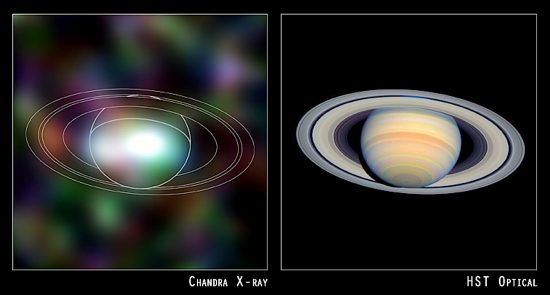
April 20, 2020
A visit to Saturn might require not only a spacesuit, but one that is armored against hard radiation.
Not all light frequencies are harmless. Everyone knows that looking directly into an arc welder should be avoided, since the plasma is so hot that it emits extreme ultraviolet light, which can damage the retina. Whenever X-rays are used to look inside the body, sensitive areas are shielded because the wavelengths are so energetic that they can ionize soft tissues, possibly destroying them.
The planet Saturn is not only a planet, but is an electrical environment, as well, causing everything from dark-mode plasma discharges to gigantic lighting bolts that flash across the ring plane. When the Cassini-Huygens spacecraft began observing Saturn, planetary scientists were shocked to discover lightning of immense power, up to a million times more powerful than anything on Earth.
However, the 90 megawatts of X-rays coming from Saturn are not attributed to its electrical nature. Instead, Saturn’s atmosphere is said to reflect X-rays from the Sun. When the discovery was made, however, the intensity of the “reflections” was “surprising.” The reason it was so surprising is that they ignored the fact that planets with magnetic fields can capture ionized particles to form a giant electrified magnetosphere.
In the past, NASA scientists reported that Enceladus, a small moon that orbits within Saturn’s ring plane, causes Saturn’s magnetosphere to bend. The effect is due to a flow of electric charge that occurs when particles from Enceladus interact with the magnetosphere of Saturn. A demonstrable electrical connection exists between Saturn and Enceladus.
Saturn emits more energy than it receives from the Sun: 2.3 times more, so it is being powered by an external source. It is also probable that the interior of the planet has its own heat. There is good evidence that Saturn once existed as an independent body from the Sun. As such, it would have received more energy in the recent past, its power source having since been usurped by the Sun.
Jupiter is similar to Saturn, discharging more energy than it receives from the Sun, although Saturn’s output is greater. The evidence suggests that Saturn was once of greater stature, but has subsequently been dethroned. According to ancient legends, Saturn occupied a position of prominence in the sky. It was not the tiny pinprick of light that can be seen on dark nights. Rather, it was worshipped as the central luminary, the all-powerful Sun. If that was the case, then its current position in the Solar System is far removed from what it once held.
Without going into details that are elaborated elsewhere, that disturbance and rearrangement of planets means that Saturn is the way it is not because of how it was conventionally formed, but because it is closer to being a star than it is to being a planet. Indeed, as our ancestors tell us, it was a star.
Stephen Smith
The Thunderbolts Picture of the Day is generously supported by the Mainwaring Archive Foundation.












